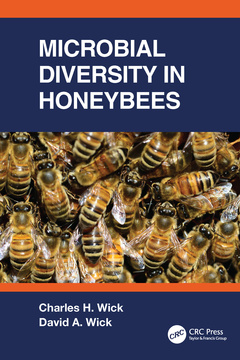Description
Microbial Diversity in Honeybees
Authors: Wick Charles, Wick David
Language: English
Subjects for Microbial Diversity in Honeybees:
Keywords
Turkey Coronavirus; Bee microbiome; Large DNA Virus; Microbe detection; Feline Infectious Peritonitis Virus; Microbial diversity; Western Equine Encephalitis Virus; Microbe identification; Honeybee Samples; Proteomics technology; Unique Peptides; Bee Gut; Infectious Bronchitis Virus; Microbe Information; Mass Spectrometry Proteomics; Montana Region; California Average; Nosema Ceranae; Nitrogen Fixing Bacteria; Raw File; Phylum Ascomycota; Apis Dorsata; Apis Florea; Phylum Proteobacteria; Apis Cerana; ASFV; Apis Mellifera; MPV; Malignant Catarrhal Fever; Human Coronavirus
Publication date: 05-2023
· 15.2x22.9 cm · Paperback
Publication date: 05-2021
· 15.2x22.9 cm · Hardback
Description
/li>Contents
/li>Readership
/li>Biography
/li>
Preface. Acknowledgments. Author/Editor Biographies. Abstract. List of Abbreviations. Microbe Diversity in Honeybees. Mass Spectrometry Proteomics. Apis. Bee Gut. Coronavirus. Bacteria. Fungi. Nosema. Viruses. Water Microbes (EPA Standards). Discussion. Bibliography. Appendix A – National Average for Bacteria. Appendix B – California Region Average for Bacteria. Appendix C – Florida Region Average for Bacteria. Appendix D – Idaho Region Average for Bacteria. Appendix E – Iowa Region Average for Bacteria. Appendix F – Montana Regional Average for Bacteria. Appendix G – National Average for Fungi. Appendix H – California Region Average for Fungi. Appendix I – Florida Region Average for Fungi. Appendix J – Idaho Region Average for Fungi. Appendix K – Iowa Region Average for Fungi. Appendix L – Montana Region Average for Fungi. Appendix M – National Average for Viruses. Appendix N – California Region Average for Viruses. Appendix O – Florida Region Average for Viruses. Appendix P – Idaho Region Average for Viruses. Appendix Q – Iowa Region Average for Viruses. Appendix R – Montana Region Average for Viruses. Index.
Dr. Charles H. Wick is a retired senior scientist from the US Army Edgewood Chemical Biological Center (ECBC) where he served both as a manager and research physical scientist and has made significant contributions to forensic science. Although his 40–year professional career has spanned both the public sector and the military, his better-known work in the area of forensic science has occurred in concert with the Department of Defense (DOD). He is a founding member of BIOid, Inc.
Dr. Wick earned four degrees from the University of Washington and worked in the private sector (civilian occupations) for twelve years, leading to a patent, numerous publications, and international recognition among his colleagues.
In 1983, Dr. Wick joined the Vulnerability/Lethality Division of the United States Army Ballistic Research Laboratory, where he quickly achieved recognition as a manager and principal investigator. It was at this point that he made one of his first major contributions to forensic science and to the field of antiterrorism; his team was the first to utilize current technology to model sub-lethal chemical, biological, and nuclear agents. This achievement was beneficial to all areas of the Department of Defense, as well as to the North Atlantic Treaty Organization (NATO), and gained Wick international acclaim as an authority on individual performance for operations conducted on a nuclear, biological, and chemical (NBC) battlefield.
During his career in the United States Army, Wick rose to the rank of Lieutenant Colonel in the Chemical Corps. He served as a Unit Commander for several rotations, a staff officer for six years (he was a Division Chemical Staff Officer for two rotations), Deputy Program Director Biological Defense Systems, and retired from the position of Commander of the 485th Chemical Battalion in April of 1999.
Dr. Wick continued to work for the DOD as a civilian at the ECBC. Two notable achievements, and one which earned h
These books may interest you

Honeybees of Asia 210.99 €



